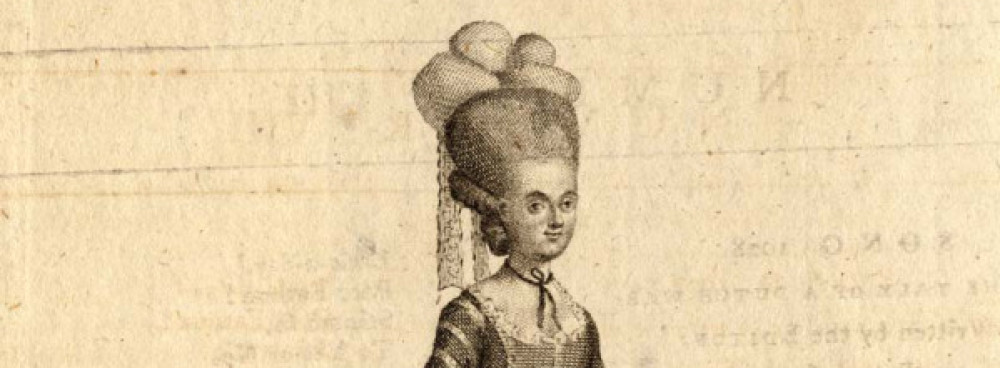(1769-1808)

Anne Brunton © Victoria and Albert Museum, London.
Francis Wemyss described her as “the wife of three husbands, and the bright particular ‘Star’ of the American Stage.”[1] William Dunlap called her “the most perfect actress America has ever seen—Mrs. Ann Merry.” [2]
Anne Brunton was born in May 1769, and one of 14 children of actor manager John Brunton, according to A Biographical Dictionary. She first appeared at Bristol in February 1785, and later at Bath, where she had a “hesitant start” but then impressed the audience.[3] In October of 1785 she debuted at Covent Garden. Over the next few years, she performed in England, adding roles to her repertoire. [4]
Around 1793, Wignell, then co-manager of Chestnut Street recruited them, and Anne

Old Chestnut Street Theatre Public Domain Image
and her husband “accepted a tempting offer from America.”[5] As Gresdna Doty observes,
No other actor previously appearing in the United States had ever held a position at a first line performer at either of London’s two patent theatres, Drury Lane and Covent Garden. [6]
Anne married Merry in 1791 “over the protest of his family, who objected to Anne’s stage career.” But they soon faced financial problems and she took Wignell’s offer, she was 27 years old and had seven years of experience as “leading actress at Covent Garden” and more than 50 roles.[7] Mrs. Merry made her debut at New Theatre, Philadelphia as Juliet on December 5 1796.”[8]
Anne then made her New York first appearance at the Greenwich Street Theatre on Aug. 23, 1797 as Belvidera.[9] Her performances evidently eclipsed those of Eliza Whitlock. As one theatre historian relates,
In 1797, it will be remembered, Mrs. Whitlock appeared in John Street, duly heralded as the Mrs. Siddons of America; but the real Mrs. Siddons of American came out at the same time in Greenwich Street, in the person of Mrs. Merry.[10]
Anne then went back to Philadelphia for second half of the 1797-8 year. Robert Merry died on Dec. 24, 1798 in Baltimore, where Merrys were for the ‘autumn campaign.’ After a period of mourning, Anne renewed her contract with Chestnut. She also acted in Washington D.C. in 1800 and 1801 “despite ill health” and then agreed to appear at the Park as guest star, at $100/ week.[11]
In 1799, Mrs. Merry appeared with Wignell’s company at George-Town [sic], and The Centinel of Liberty proclaimed her “unquestionably the best serious actress that ever graced an American stage.” [12] On April 12, 1800, the Philadelphia Gazette and Universal Daily Advertiser warned that tickets were scarce for Mrs. Merry’s benefit:
We understand that at 10 o’clock this morning, when her box-book was opened, the demands for seats were so numerous and urgent as to occasion great struggle among the applicants. FIFTY dollars were offered for eight seats.[13]
The April 14th edition, however, noted,
To rectify a misapprehension among Mrs. Merry’s friends, respecting the situation of the boxes for this evening, we are desired to state, that there are not so many seats engaged as to preclude the prospect of general accommodation. [14]

Park Theatre Public Domain Image
According to A biographical Dictionary, Mrs. Merry “acted principally in Philly but also made additional appearances in New York and other major theatrical centers of the union, including Boston.[15] Odell relates that Mrs. Merry returned to the Park for a two week engagement in April of 1802 and quotes a review in The New York Evening Post, April 20 1802:
Last evening Mrs. Merry again honored our boards wit her presence . . .on her entrance loud and reiterated welcome was heard from every part of the house. This tumultuous expression of their delight gave place, at the first word she uttered…[16]
In 1803, when Anne Brunton Merry was 33 years old, she married Thomas Wignell, but her new husband died seven weeks after the wedding. Anne acted in Baltimore in April and had a daughter Elizabeth in the autumn of 1803.[17] In August of 1806, she marries Warren, manager, in Baltimore, and appeared as Mrs. Warren for the first time in October of 1806 at Baltimore. By March 1808, “inclining toward corpulency,” and audiences “were waning.”[18] She died on June 28, 1808—after having delivered a still born son on June 24. An obituary in the New York Commercial Advertiser praised her “unrivalled excellence in her profession” and her “unsullied fame.” [19] Anne is buried in churchyard of Christ Church n Alexandria on corner of N. Columbus and Cameron Streets with a “well preserved sarcophagus.”[20]
Other Works:
See also Doty, Gresdna Ann. The Career of Mrs. Anne Brunton Merry. In The American Theatre. Baton Rouge: Louisiana State University, 1971.
NOTES
[1] Francis C.Wemyss, Chronology of the American Stage From 1752 to 1852. New York: Wm.
Taylor & Co., 1852
[2] Dunlap, William. History of the American Theatre. New York: Burt Franklin, 1963, 336.
[3]Highfill, Philip H., Kalman A. Burnim, and Edward A. Langhans. A Biographical Dictionary of
Actors, Actresses, Musicians, Dancers, Managers & Other Stage Personnel in London,
1660-1800. Vol. 10. Carbondale: Southern Illinois University Press, 1973. Print, 66.
[4] Highfill, 72.
[5] John Durang. The Memoir of John Durang. Ed. Alan S. Downer. Pittsburgh: U of Pittsburgh Press,1966), 157
[6] Gresdna Doty. “Anne Brunton Merry: First Star.” In Women in the American Theatre. Eds. Chinoy, Heln Chinoy and Linda Walsh Jenkins. 60-65 USA: Theatre Communications Group, 1987, 52.
[7] Doty, 54.
[8] Durang, 157.
[9] Highfill, 73.
[10] George C.D. Odell, Annals of the New York Stage, New York: Columbia University Press, 1927, 157.
[11] Highfill, 73.
[12] The Centinel of Liberty, and George-Town and Washington Advertiser. 27 August, 1799.
[13] The Philadelphia Gazette and Universal Daily Advertiser. 12 April, 1800.
[14]The Philadelphia Gazette and Universal Daily Advertiser. 12 April 1800; 14 April 1800.
[15] Highfill, 74.
[16] Odell, II, 135.
[17] Highfill, 75.
[18] Ibid.
[19] New-York Commercial Advertiser. 5 July 1808.
[20] Highfill, 76.
